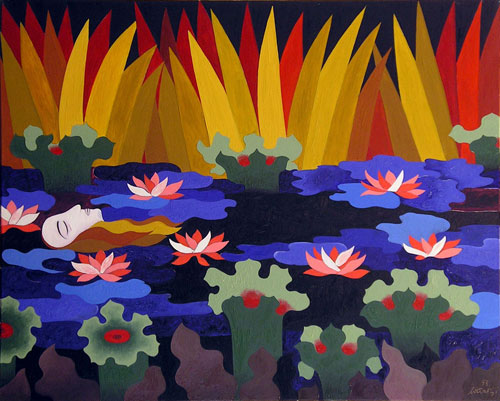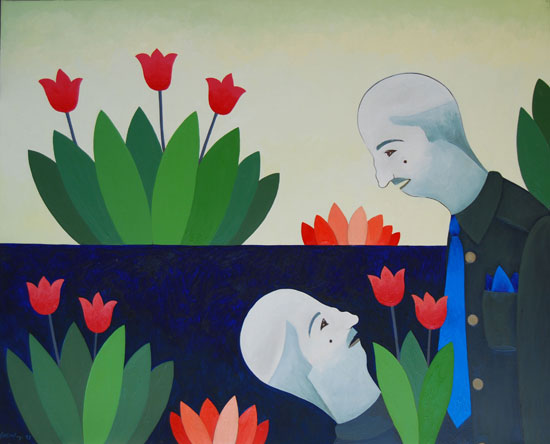L’Homme et son Image pour M. Le Marquis de la Rochefoucault, 1993, 81 x 100 cm
Born in New York in 1930 to Lebanese parents, Willy Aractingi’s early years were shaped by a life on the move. He spent his childhood in Egypt before moving to Beirut in his teens. Losing his parents early, he was raised by extended family and turned to painting at the age of 12. But art, for much of his adult life, was a luxury he stepped in and out of to make room for more pressing priorities – work, family, and downright survival. Aractingi would go back to art every chance he could, starting a modern gallery that exhibited Fassianos, Niki De St Phalle, and Alan Davies years before the Lebanese civil war, sketching and painting in his spare time, and dedicating his schedule fully to painting as of the mid-eighties – starting on his Fables de la Fontaine magnum opus in 1995.
Aractingi would never leave art again until his death in 2003. And he would never quite abandon the childlike lens through which he viewed the world. Instead, a sense of arrested development echoes through his pieces, making his unfinished childhood business permanent on canvas.
Nowhere is that sense of youthful yearning more vivid than in his Fables de La Fontaine series. At a glance, his fable depictions are bright and playful. Look closer, and the satire sharpens. In Les Voleurs et l’Âne (The Thieves and the Donkey), he absurdly paints the comic allegory of distraction and loss, with two men arguing bitterly over a white mule while another makes off with it. In Le Rat qui s’est retiré du monde (The Rat Who Withdrew from the World), he effortlessly conveys the potent metaphor for social alienation, as a single rodent slips into the shadows of a wheel-like sanctuary while the others scurry around a candlelit stage.

Le Rat qui s’est Retiré du Monde, 1993, 81 x 100 cm

Les Voleurs et l’Âne, 1989, 81 x 100 cm
A self-described “naïve primitive”, Aractingi would likely shrug off such praise for what is, at its heart, simple and playful visual storytelling – and a view of the world to match. Though self-taught, his art nods to greats like Henri Rousseau and Paul Gauguin. His paintings are mostly oil or acrylic on canvas, always potent in color and candor. Like Rousseau, Aractingi’s nature is imaginative rather than observed. Like Gauguin, his figures are stylized, flat, and symbolic. But his voice is unmistakably his own: more intimate, more absurd, less complex, and often, very personal. That’s because he has always folded into his works motifs from Egyptian folktales, Beirut street life, and the mythical stories of Antar and Abla, weaving East and West.
Despite the seeming simplicity of his choices, his resolve to paint all of La Fontaine’s fables in oil on canvas – making him the only artist to have done so – seems rather intentional, as though a closure to his interrupted artistic path. And so does his craft’s progression from the small, raw, and innocent paintings of his early career to the more complex, bigger, and louder pieces of his later work.

Le Berger et la Mer, 1993, 81 x 100 cm

La Femme Noyée, 1993, 81 x 100 cm
Aractingi’s art plays, pokes, and prods. But it has been received very seriously. His works have resonated with the art community across the globe, having been showcased in Lebanon, France, the United Kingdom, and the US, and found in prestigious public and private collections worldwide – including a large number held at Beirut’s Sursock Museum. About 100 of his fables had been permanently exhibited until his death at a museum on the Jean de La Fontaine historic route near Paris, and some have even been selected for none other than Air France’s in-flight menu front cover.
Whichever depth one chooses to dissect Aractingi’’s works, the consensus is that behind their humor is human nature. Behind their caricature is commentary. And behind their every fable is a man who, despite all interruptions, never stopped telling stories.
Images source: aractingiwilly.com

